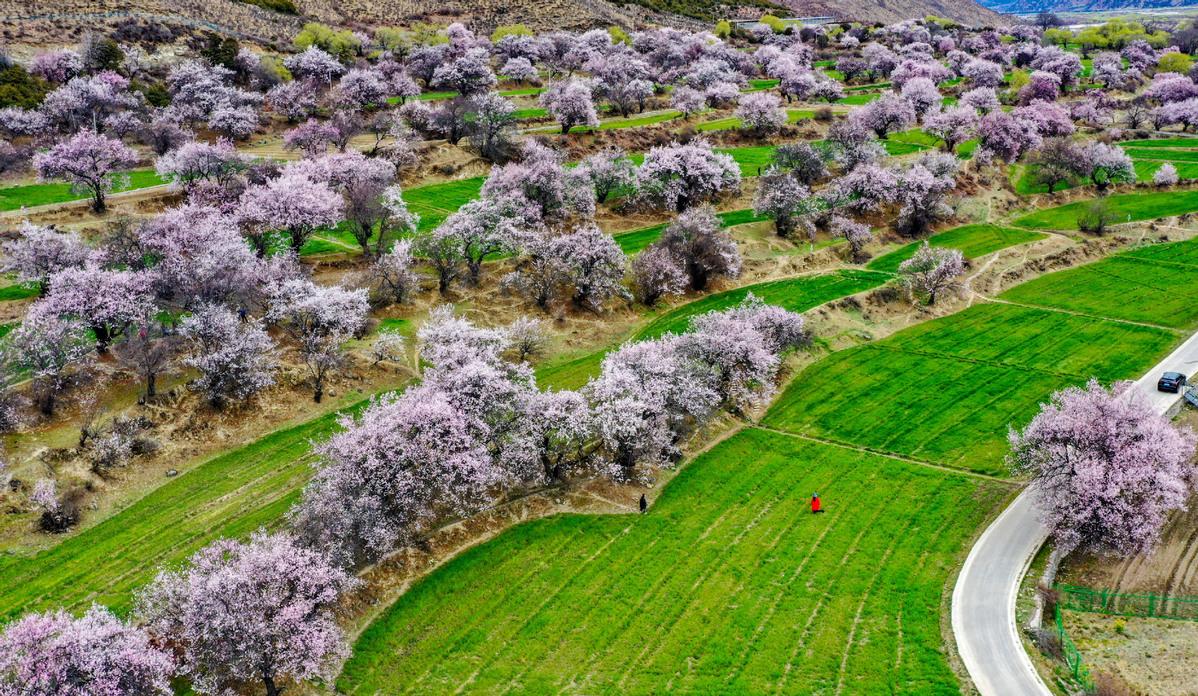Tibet Story: Researcher digs into peach trees to benefit people on plateau

Tourists have fun among peach blossoms in Duodang village in Bayi district, Nyingchi, Southwest China's Tibet autonomous region, March 25, 2023. [Photo/Xinhua]
LHASA - It is early spring, and peach blossoms are in full bloom in the city of Nyingchi, southwest China's Tibet Autonomous Region, where the signature peach blossom festival opened in late March, while two wild peach trees grown at an altitude of 4,498 meters in the regional capital Lhasa are still in dormancy.
"Due to the low temperature at such a high altitude, the flower buds will end dormancy around the end of April, and the flowering period starts on May 20," said Zeng Xiuli from the Tibet Academy of Agriculture and Animal Husbandry Sciences, who has studied the plateau region's wild peach trees for 16 years.
In 2007, Zeng, then aged 37, arrived in Lhasa and has been dedicated to studying wild peach trees on the plateau ever since.
"There are more than 300,000 wild Tibetan peach trees from about 1,700 meters above sea level in Metok County of Nyingchi to 4,498 meters on Lhari Nyangbu Mountain of Lhasa," Zeng said.
The wild Tibetan peach, with thousands of years of history, amounts to the ancestor of peach trees.
After thorough investigation and sampling for months, Zeng started to plant the wild variety in a barren floodplain belonging to her academy.
"Without any help, we did everything from scratch. When the saplings grew, we had no idea whether they would bear fruits at all," she recalled.
Finally, her attempts presented fruitful results in the autumn of 2013. Zeng shared the first batches of the peaches with her research team and locals and then began her new round of research -- sending her saplings to Tibet's villages at different altitudes.
"The academy brought us saplings and planting techniques, and then we started planting peach and apple trees in our orchards," said Tashi, a villager in Nyingchi. He now earns more than 100,000 yuan (about ¥14,500) annually thanks to the fruits and booming local tourism.

Aerial photo shows peach blossoms in Milin county in Nyingchi, Southwest China's Tibet autonomous region, March 26, 2023. [Photo/Xinhua]
Nowadays, large quantities of peach saplings selected by the regional agricultural and animal husbandry academy are planted across Tibet, even in Ngari Prefecture, where the average altitude is among the region's highest.
"Seeing residents enjoy fruits grown at their doorstep, I'm more than content, as they've all grown out of the saplings planted in the barren land years ago," said Zeng.
In the winter of 2019, the diligent researcher occasionally found two wild Tibetan peach trees at an altitude of 4,498 meters.
Though the two peach trees were bare and dormant then, they helped the researchers further study the genetic basis of perennial woody fruit trees to adapt to the high-altitude environment.
"This year's peach blossom festival is more lively than ever before," said Nyima Chokyi, a villager from Kala Village, Nyingchi.
The small village has been the venue for the festival's opening ceremony for years, as it boasts vast patches of peach trees, mostly the wild variety improved by Zeng's academy.
During the first two days of this year's festival, Kala Village received about 67,000 tourists, raking in a total ticket revenue of nearly 2 million yuan.
The tourism revenue of Nyingchi is expected to reach 9.2 billion yuan this year, according to the city's tourism development bureau.
But the tourism boom means anything but an end to Zeng and her research fellows' cause.
"Some peach trees in Kala Village have aging problems and poor flowering. Our academy plans to fix the problem and provide relevant technical training for the locals in the coming four to five years," said Zeng.
